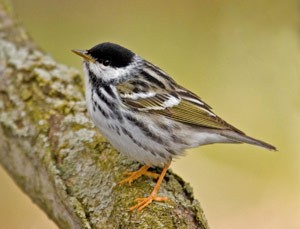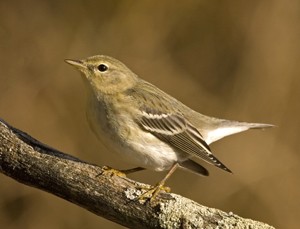When they arrive each spring, displaying color and song and romance, birds are faithful to their given names. Chestnut-sided warblers have chestnut sides. Indigo buntings are indigo. And scarlet tanagers are scarlet. But no more. The summer of songbird love is over. The molt begins.
Most birds gradually replace (molt) some or all of their feathers after the breeding season. Many get a complete makeover, going from ornate to ordinary. It can frustrate some birdwatchers who, even in the best of times, can barely find the ring on a ring-necked duck or the yellow on a yellow-bellied sapsucker.
The molt is a good thing. Birds need new feathers this time of year. Take the blackpoll warbler, for example. Males arrived in our coniferous woods back in May, wearing a distinguished black cap (poll) and stripes from the sides of the breast to the flanks. Blackpolls are like angels, with grace, feathers, and flight creating radiance without the benefit of color. But over the course of mating and raising young, a songbird’s feathers, essentially dead tissue, become worn, broken, and a bit frayed at the edges. By fall, those feathers would not easily carry a blackpoll to its wintering grounds in South America. So after the rigors of breeding, but before the flight south, they grow a new set.
In many birds, the new feathers resemble the old ones, or some muted version of them. But in some, like the male blackpoll, the molt seems to create an entirely new bird. You can get a sense of the transformation in my accompanying photos. Since he no longer needs to appear flashy in order to attract a mate, he might as well become camouflaged in order to avoid predators (and confound birdwatchers). In his legendary field guides, Roger Tory Peterson noted the significance of the molt by including a plate of drab birds titled “Confusing Fall Warblers.”
Compounding the confusion is that many songbirds that hatched this year look nothing like mom and dad. It’s why the common names don’t work for juvenile spotted sandpiper, red-tailed hawk, and female chestnut-sided warbler. And in the fall, cryptic-looking youngsters outnumber their parents. Just do the math: two adult blackpoll warblers come north to breed; those two plus their four drab young (perhaps even a second clutch of four) are now flitting about and preparing to go south. (By the way, that bland blackpoll in the lower photo is actually one of those youngsters; adult males molt to a similar plumage in fall, and adult females, despite their molts, always look this plain.)
Knowing the magic of the molt explains why, in fall, we never see male bobolinks dressed in black, white, and gold, or tanagers that are actually scarlet. Fear not, however, the males are still out there. They’ve only traded in their shocking plumage for the drabber duds of winter. The good news is that while they are gone, they will molt yet again and put on their finery for the show next spring.




Discussion *